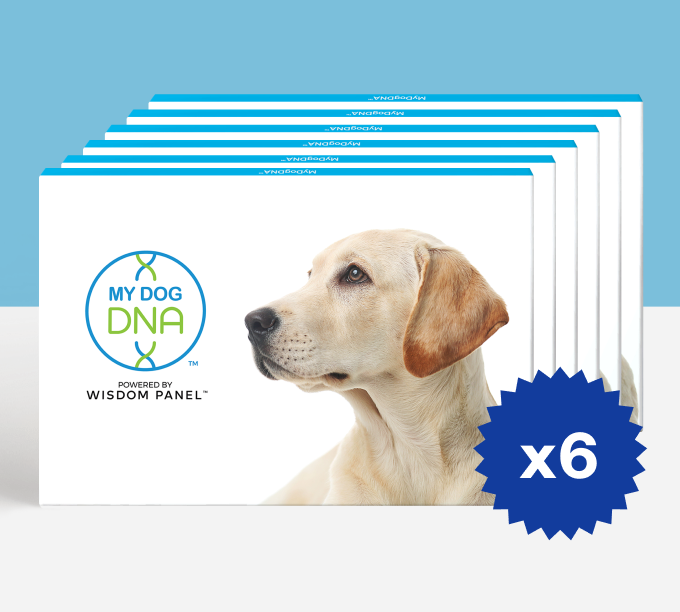About the English Shepherd Dog
You don’t meet an English Shepherd Dog every day. If you’re lucky enough to encounter one, you're likely to find an intelligent, loyal and hard-working character who looks like the quintessential farm dog of centuries past. Known by a variety of names, including Old Fashioned Collie, Farm Collie and American Farm Shepherd to name a few, English Shepherds are sturdy and medium-bodied, sporting a durable double coat in a variety of color combinations —excepting merle-- similar to other herding breeds such as collies. Although not registered by The Royal Kennel Club of the UK nor the American Kennel Club, the United Kennel Club has recognised this distinct breed since 1927. English Shepherd foundation stock, as the name suggests, originated in the UK, and accompanied British and Irish immigrants to North America starting in the early 1800s. The English Shepherd was quite popular in the last century but is now considered a rare breed.
Progressive Retinal Atrophy (PRA) in the English Shepherd
When a breed of relatively low census, such as the English Shepherd, encounters an inherited disorder the effect can rapidly devastate breeding programs and threaten the entire breed’s future. So it caused grave concern when two English Shepherds were recently diagnosed with an inherited form of blindness called Progressive Retinal Atrophy (PRA). These two cases of PRA in ESDs were brought to the attention of a team of canine geneticists led by Dr. Cathryn Mellersh at the Canine Genetics Centre at the Department of Veterinary Medicine, University of Cambridge. A concerted research effort was undertaken, and Wisdom Panel’s Dr. Oliver Forman is proud to have contributed to this important work that led to discovery of the genetic cause of the disorder.
The Variant Discovery Process
After the initial two cases were discovered, an organised search for similar cases in the ESD began. As word spread, a few additional PRA-affected ESDs were identified and DNA samples from these dogs were collected.
Criteria included ESDs who had normal vision throughout their first few years of life but by ages 5-7 were showing signs of “late-onset” PRA. The next step in the project was to rule out already-known PRA-causing variants. prcd-PRA, the number one culprit across many breeds, was quickly ruled out. This was notable because prcd-PRA is known to occur in ESDs and its clinical signs are comparable to what was observed in these cases. All other known causes of PRA were also eliminated through DNA screening, and a search for the causative mutation was launched.
Thanks to many decades of foundational research and technological advances, the pace of discovery of new genetic variants is remarkably faster than in years past. That said, genetic research still requires considerable effort, money and expertise and at times a bit of luck to succeed. Wisdom Panel’s bank of data greatly aids in this type of research and such was the case with the ESD PRA investigation. Through collaboration with Wisdom Panel™ and other groups, not the least of which were the English Shepherd breeders themselves, scientists at University of Cambridge and Wisdom Panel™ were able to screen several hundred English Shepherd Dogs, and characterise a novel genetic variant in a gene called FAM161A, showing that it was the causal variant for ESD PRA. A 2024 publication describes the research methods and results.

Findings & Clinical Signs
Two copies of a mutation in the FAM161A gene were observed in all PRA-affected ESDs but not in unaffected ESDs nor in any other dog breeds, suggesting this variant is private, or unique to the English shepherd dog breed. Affected dogs carried two copies of the variant, and ESDs carrying only one copy of the FAM161A variant did not develop PRA. This fits the pattern of simple autosomal recessive inheritance, as seen in most other known PRAs. At the time of publication, 47 ESDs had been tested for the variant, and it was found in ESDs located in both the UK and the US with an allele frequency of 28%. Interestingly, a few years earlier, a different mutation in this same FAM161A gene was shown by the Cambridge group to be responsible for late-onset PRA in the Tibetan Terrier and Tibetan Spaniel, and a similar mutation is also seen in humans with a similar condition.
As with most PRAs, onset is in middle to older-aged dogs, and is first noted as loss of night vision. With progression of disease and retinal degeneration, dogs eventually experience total blindness and loss of all visual reflexes. Although only a handful of English Shepherd Dogs have been formally diagnosed with this condition, the median age at diagnosis was estimated at around 5 years.
Fast facts:
- ESD PRA appears to be a simple recessive condition
- In the small sample size tested thus far, the allele frequency in the ESD is 28%
- The variant is found in UK and US populations of the breed
- Median age of onset is estimated at 5 years
- Loss of night vision precedes blindness

Next Steps
This discovery was excellent news for the ESD breed, as the development of a genetic test allows breeders to reduce risk of blindness in future dogs, while retaining as many potential breeding dogs for matings as possible to preserve the gene pool. A DNA test for the ESD form of PRA is now available at the University of Cambridge’s Department of Veterinary Medicine Animal Genetic Testing lab. Wisdom Panel™ hopes to add this DNA test to MyDogDNA™ and Optimal Selection™ Canine for our breeders in the coming year. This will complement the existing health tests of interest for ESDs, which currently includes Collie Eye Anomaly (CEA), Multi-Drug Resistance1 (MDR1) and prcd-PRA.
The story of PRA in the English Shepherd Dog is a happy one, and suggests the power of genetic research and testing to truly improve the health of future generations of purebred dogs. Vigilance in routine health screening programs, including eye exams for breeding dogs and their offspring, followed by swift action on the part of conscientious breeders as in this case, will help prevent further spread of genetic disease. Through DNA testing, ESD breeders are now able to continue their lines with knowledge that none of the offspring will develop this or other known inherited disorders. Along with the health, diversity and trait information, breeders can gain valuable insight into their dogs’ inheritance with Wisdom Panel™ breeder testing at MyDogDNA
References:
Stanbury et al. Exonic short interspersed nuclear element insertion in FAM161A is associated with autosomal recessive progressive retinal atrophy in the English Shepherd. Genes (Basel) 15:952, 2024. Pubmed reference: 39062732. DOI: 10.3390/genes15070952.








